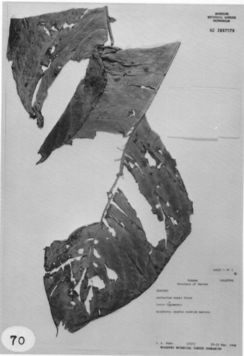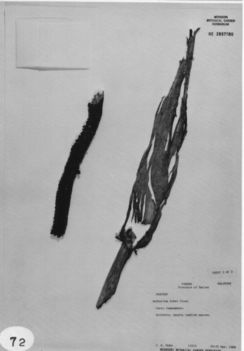





TYPE: Panama. Darien: Cerro Campamento, S of Cerro Pirre, cloud forest. Duke 75572 (MO 2897078-80, holotype; US, isotype).
LEAVES with petioles 65-75 cm long, 8-9 mm diam., sometimes with many low ridges; blades thin, ovate-triangular, long-acuminate at apex, deeply lobed at base, 56÷85 cm long, 24-55 cm wide, broadest at point of petiole attachment; anterior lobe 40-52 cm long, the margins straight to convex; posterior lobes 14.5÷25 cm long; sinus hippocrepiform, the apex rounded; both surfaces drying matte; midrib raised above and below, basal veins 6-8 pairs, the first and second, sometimes third, free to the base, the fourth and higher coalesced 2.5-5 cm or more, raised above and below (dry); posterior ribs broadly curved, naked for most of the length; primary lateral veins 12-20 per side, departing midrib at 45-55° angle, straight or weakly arching to collective vein, raised above and below, yellow below (dry); interpri-mary veins as prominent as primary lateral veins (dry); collective veins arising from one of the lowermost basal veins, loop-connecting the primary lateral veins, prominulous above, raised and yellow below (dry), 2-4 mm from the margin, sometimes only scarcely removed from margin.
INFLORESCENCE with peduncle 51-64 cm long; spathe green, 15-35 cm long, 2.5-4 cm wide. oblong-lanceolate, moderately thin; spadix reddish to maroon, 15-32 cm long, 1.5-2.5 cm diam. near base, 0.7-1 cm diam. near apex; flowers (post-anthesis) rhombic to 4-lobed, 1.5-2.2 mm long, 1.2-2.7 mm wide, the sides straight to smoothly sigmoid, 8-12 flowers visible in the principal spiral, 13-19 flowers visible in the alternate spiral; lateral tepals 0.8-1 mm wide, the inner margin convex.
INFRUCTESCENCE 38-67 cm long, 3-3.5 cm diam. with berries exsert-ed; berries red, oblong-elliptic, ca. 1 cm long, moderately acute at apex. Figs. 70 and 72.
Anthurium dukei is known only from Panama in Darien Province in tropical wet and premontane rain forest at 600 to 1,600 m.
The species is tentatively placed in section Belolonchium and is recognized by its large, green-drying, relatively thin, ovate-triangular leaves with numerous primary lateral veins and with the interprimary veins only slightly less conspicuous than the primary lateral veins. Other distinguishing features include its thin lanceolate spathe and very long infructescence with red berries. Also characteristic is the way the collective vein extends uniformly close to the margin of the blade after arising usually from the lowermost basal vein.
Anthurium dukei is similar to A. rotundistigmatum in terms of leaf blade shape and color, but the latter differs in having the collective vein generally arising from one of the primary lateral veins and in having a short-pendunculate inflorescence. It may be confused with A. panamense from CoclŽ and Veraguas Provinces, but that species has a more elongate blade and a creamy white spadix.
The species was first collected by R. S. Williams in 1908; A. williamsii, named in honor of the same collector, precludes naming this species in his honor. It was later collected by Dr. James A. Duke in 1968 during his explorations ofDa-ri6n. The type specimen was collected by Duke and is named in his honor.
 |
 |
DARIEN Col—nacute;n (Colombia): Alturas de Nique, southernmost peak of Cerro Pirre massif, Gentry et at. 28701 (MO).
DARIEN: Cerro Campamento, Duke 15572 (MO, US); summit of Cerro Pirre, Gentry 4595 (MO); E of Tres Bocas, Kirkbride & Duke 1161 (MO).